When he announced the Jubilee Year that would begin Dec. 24, 2024 and continue until Jan. 6, 2026, the late Pope Francis chose “Pilgrims of Hope” as the theme for the Holy Year.
“The pilgrimage expresses a fundamental element of every Jubilee event,” he said, adding that “in the coming year the pilgrims of hope will not fail to travel ancient and modern routes to live intensely the Jubilee experience.”
Making a pilgrimage, going to Confession, receiving Communion and offering prayers to receive an indulgence are key parts of the Holy Year observance.
Unlike a pleasure trip or a vacation, a pilgrimage has a spiritual purpose. It mirrors our own life’s journey toward heaven. It motivates us to think more about our obligation to our faith and to our fellow human beings. It helps us remember to call on God and to trust in His mercy. Pilgrimages remind us of our call, our vocation, to holiness.
Those who make a Holy Year pilgrimage may obtain a plenary indulgence under the usual conditions: sacramental Confession, reception of Holy Communion, prayer for the intentions of the pope and full detachment from sin. The Church teaches that a plenary indulgence removes all temporal punishment due to sin when these conditions are met in connection with an indulgenced act, such as pilgrimage and prayer.
After the Jubilee Year 2025 was announced, Cardinal Wilton Gregory, then the archbishop of Washington and now the archbishop emeritus, named Jubilee churches for sacred pilgrimages at nine local parishes within the Roman Catholic Archdiocese of Washington.
He also designated as pilgrimage sites the University of Maryland Catholic Student Center in College Park, Maryland and the Saint John Paul II National Shrine in Washington, D.C. The Basilica of the National Shrine of the Immaculate Conception in Washington, D.C., was designated as a special place of pilgrimage for Jubilee Year 2025 by the Administrative Committee of the United States Conference of Catholic Bishops.
The following are the Jubilee Churches within the Archdiocese of Washington:
• Cathedral of St. Matthew the Apostle, Washington D.C.
• Basilica of the National Shrine of the Immaculate Conception, Washington D.C.
• Holy Comforter - Saint Cyprian Catholic Church, Washington D.C.
• Shrine of Saint Jude, Rockville, Maryland
• Saint John Neumann Catholic Church, Gaithersburg, Maryland
• Sacred Heart Catholic Church, Bowie, Maryland
• Saint Bernard of Clairvaux Catholic Church, Riverdale, Maryland
• Saint Anthony Catholic Church, North Beach, Maryland
• Sacred Heart Catholic Church, La Plata, Maryland
• Saint Aloysius Catholic Church, Leonardtown, Maryland
• Saint John Paul II National Shrine, Washington D.C.
• University of Maryland Catholic Student Center, College Park, Maryland
The Roman Catholic Archdiocese of Washington’s website at adw.org has a special web page related to the Jubilee Year and the local Jubilee Churches: https://adw.org/the-year-of-the-jubilee-2025-pilgrims-of-hope/
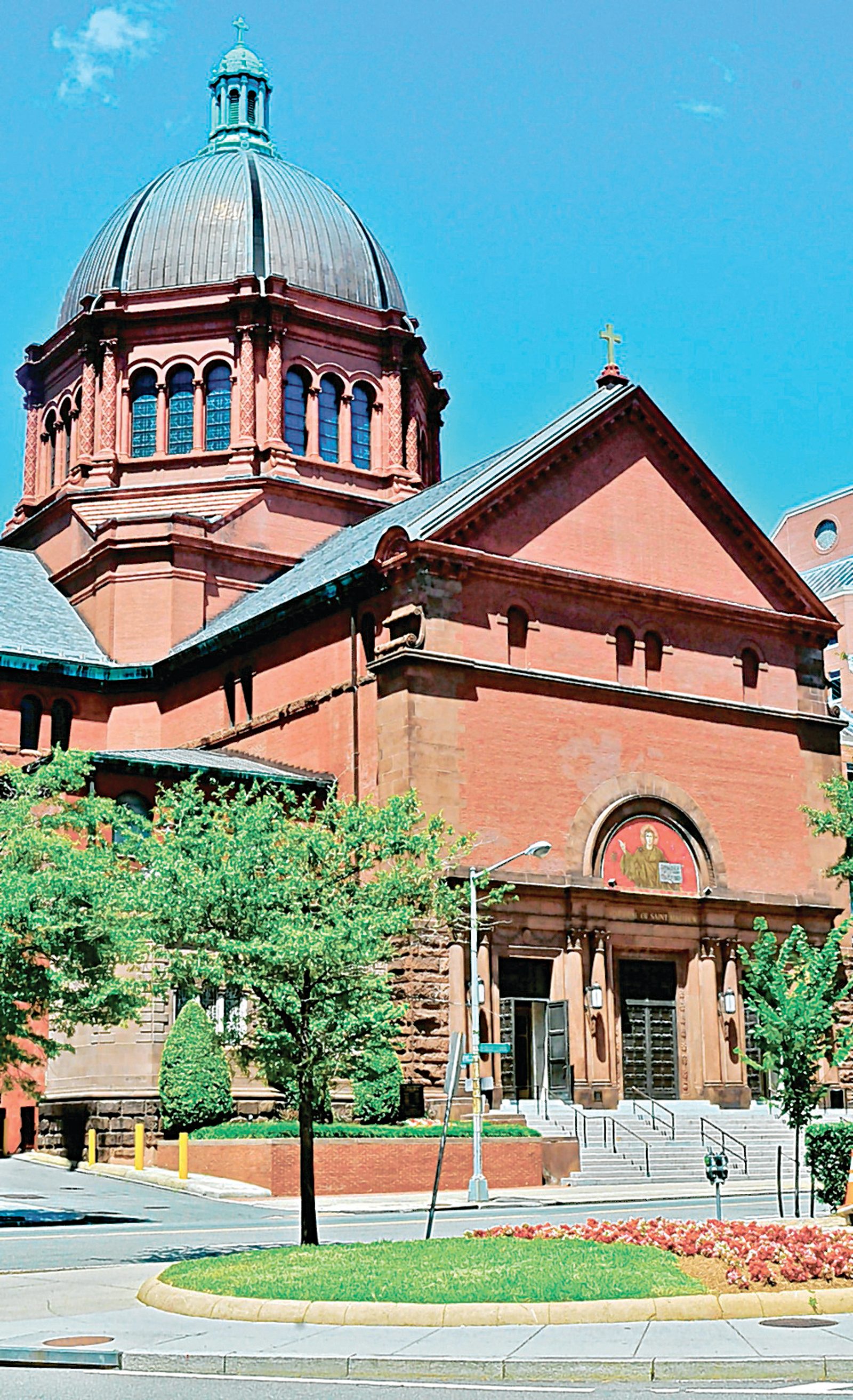
Cathedral of St. Matthew the Apostle, Washington, D.C.
The theme for the Catholic Church’s Jubilee Year 2025, “Pilgrims of Hope,” is especially fitting for the people who come to pray at the Cathedral of St. Matthew the Apostle in Washington, D.C., its rector said in an interview.
“Even more so this year, there’s a need for hope, in the Church and in society,” said Msgr. W. Ronald Jameson, who has served for 40 years at the cathedral, including the last three decades as rector.
Cardinal Wilton Gregory, then the archbishop of Washington and now the archbishop emeritus, celebrated an opening Mass for the Jubilee Year on Jan. 1 at St. Matthew’s Cathedral, which he had designated as one of the Jubilee Churches for sacred pilgrimages during the Jubilee Year in the Roman Catholic Archdiocese of Washington.
The cathedral is named for St. Matthew, a tax collector who became an apostle of Jesus and who is the patron saint of civil servants, which the rector noted is so appropriate for that church in the nation’s capital. Recent months have been a time of anxiety and uncertainty for federal workers impacted by a significant reduction in that workforce, and for the immigrant community as a mass deportation policy of undocumented immigrants is being enforced.
Msgr. Jameson said people facing challenges are “looking for a sense of hope,” and he said the cathedral through its liturgies, programs and outreach can help people know that Christ offers them hope, that “the Lord is with them… They’re not alone.”
Every day, Catholics from all walks of life, from across the United States and from around the world, come to pray at St. Matthew’s Cathedral. In a city of monuments, the cathedral in downtown Washington is a landmark of faith in the nation’s capital.
The parish was established in Washington, D.C., in 1840, and the present church was designed by the noted architect Christopher Grant La Farge, with its cornerstone blessed in 1893 and the first Mass celebrated there in 1895. St. Matthew’s was named the cathedral church for the newly formed Archdiocese of Washington in 1939.
As the cathedral church, it is the mother church for Catholics in the Archdiocese of Washington and the seat of the archbishop, Cardinal Robert W. McElroy, who celebrates major Masses there. With its liturgies, educational programs and outreach to the poor, St. Matthew’s Cathedral plays a major role in Catholic life in the nation’s capital.
Msgr. Jameson noted that all the works of art in the cathedral “say something about living a life of Christ.”
He noted how beneath the gleaming copper dome of St. Matthew’s Cathedral that points heavenward, majestic mosaics depict the four evangelists and illustrate the power of the word of God to change lives. A dramatic mural of saintly people of the Americas demonstrates that people from all walks of life are called to be holy. A statue of Mary gracefully pointing upward shows that Mary leads people to Jesus. A chapel with colorful mosaics illustrating the life of St. Francis of Assisi demonstrates the call of Christ’s followers to be stewards of the Earth and instruments of His peace and love.
The cathedral’s website at https://www.stmatthewscathedral.org/ has a link to a web page listing special Jubilee events there, including an adult catechesis series on the history of the Church and on the Gospel of John, and a parish weekend retreat from Aug. 29-31.
In addition to listing conditions for seeking a plenary indulgence, the web page encourages people to participate in the Jubilee by performing Corporal and Spiritual Works of Mercy and by participating in times of prayer and in programs to learn about the faith. The cathedral has a Jubilee Cross in the sanctuary, and brochures for pilgrims include a Jubilee Cross Prayer to reflect on Jesus’s love and sacrifice
Over the years, the Cathedral of Saint Matthew the Apostle has been a witness to history. On Nov. 25, 1963, the Requiem Mass for President John F. Kennedy, the nation’s first Catholic president, was held at the cathedral, three days after the president was assassinated. During his first pastoral visit to the United States, Pope St. John Paul II celebrated Mass at St. Matthew’s Cathedral on Oct. 6, 1979, and Pope Francis joined the nation’s Catholic bishops for midday prayer there 0n Sept. 23, 2015. Each year, the cathedral hosts the Red Mass on the Sunday before the first Monday in October when the Supreme Court begins its term.
St. Matthew’s Cathedral is located at 1725 Rhode Island Ave., N.W., in Washington, near the Farragut North and Dupont Circle stops on Metro’s Red Line. The cathedral is open on Mondays through Fridays from 7 a.m. to 6:30 p.m., on Saturdays from 7 a.m. to 7 p.m., and on Sundays from 6:30 a.m. to 7 p.m.
Masses at the cathedral are celebrated Monday through Friday at 7:30 a.m., 12:10 p.m. and at 5:30 p.m., but there is no 5:30 p.m. Mass on federal holidays. On Saturdays, Masses are celebrated at 7:30 a.m. and 12:10 p.m., and the Vigil Mass is at 5:30 p.m. On Sundays, Masses are celebrated at 7 a.m., 9 a.m., 11 a.m., 1 p.m. (Spanish) and 5:30 p.m. (interpreted for the Deaf on most Sundays).
The Sacrament of Reconciliation is offered at the cathedral on Mondays through Fridays from 11 a.m. to noon (except on holy days and federal holidays). Confessions are also offered on Saturdays from 4 to 5 p.m. and by appointment. The cathedral has Adoration of the Blessed Sacrament on Mondays through Fridays from 11 a.m. to noon (except on holy days and federal holidays), on First Fridays from 12:45 p.m. to 5 p.m., and on the third Monday of each month from 6 to 7 p.m. – By Mark Zimmermann
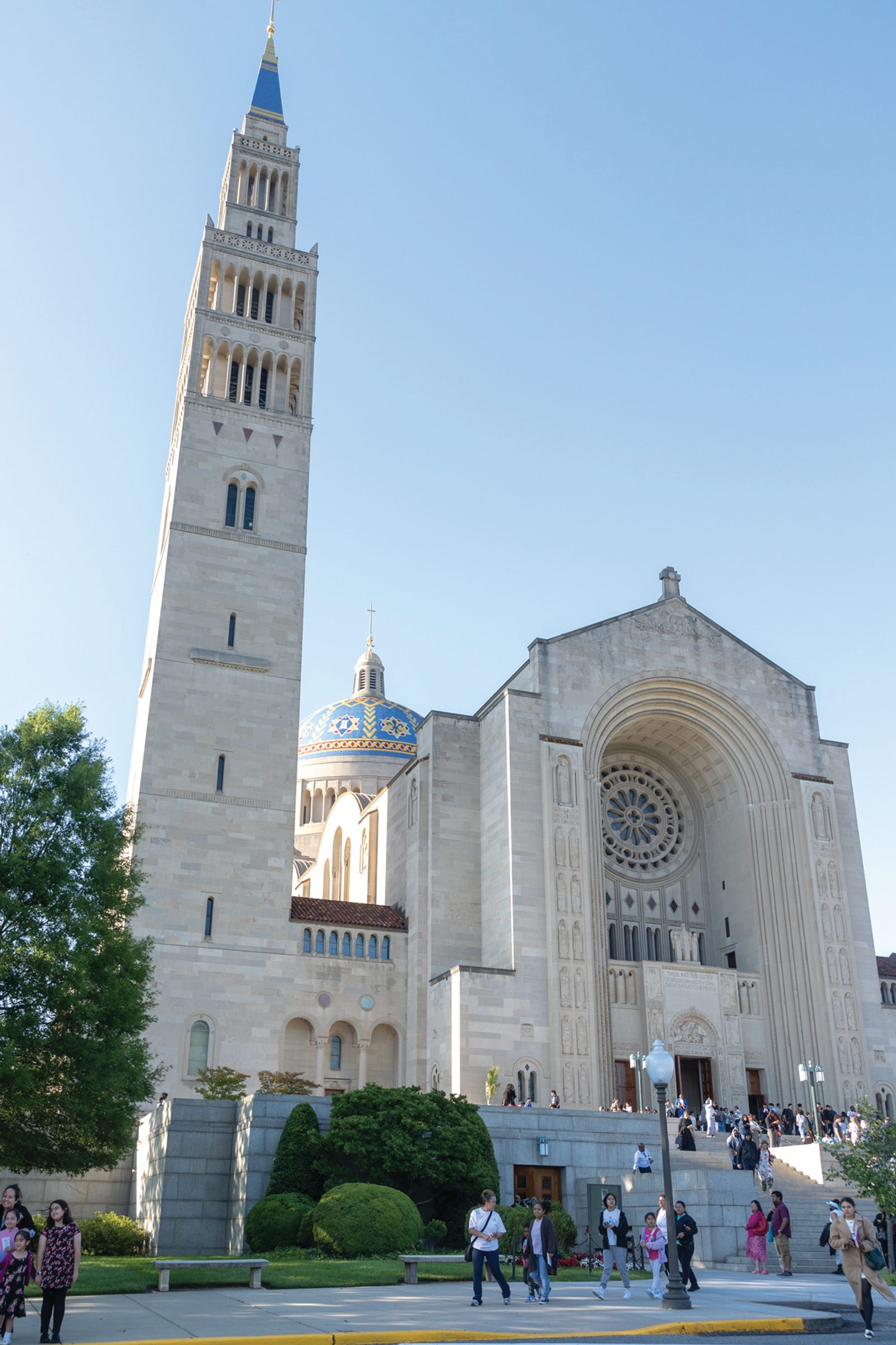
Basilica of the National Shrine of the Immaculate Conception
Among the 12 churches and shrines located within the Roman Catholic Archdiocese of Washington that have been designated as a Jubilee Year sacred pilgrimage sites is the largest Catholic church in North America and one of the 10 largest in the world.
During its more than 100-year history, the Basilica of the National Shrine of the Immaculate Conception in Northeast Washington, D.C. has been welcoming pilgrims from throughout the archdiocese and from across the world.
“To go on pilgrimage to the Basilica of the National Shrine of the Immaculate Conception is to place yourself at the foot of Our Lady, and to ask the intercession of the Mother of God who always hears the prayers of his children,” said Msgr. Walter Rossi, rector of the National Shrine.
Pilgrims visiting the National Shrine will follow in the footsteps of popes and saints who have prayed there. Saint Teresa of Calcutta (Mother Teresa) was a frequent visitor. Pope (now Saint) John Paul II visited in 1979; Pope Benedict prayed there in 2008 and Pope Francis made an historic visit in 2015.
On Sept. 23, 2015 the first-ever canonization to take place on American soil was held at the National Shrine as Pope Francis canonized St. Junípero Serra, the 18th century Spanish Franciscan missionary priest who established nine missions in California.
Last year, the National Shrine marked the centennial of the first public Mass offered there, although the history of the National Shrine dates back even earlier.
In 1913, Bishop Thomas Shahan, rector of The Catholic University of America, proposed building a national shrine dedicated to Our Lady under her title of the Immaculate Conception. It is under that title that Mary is honored as the patroness of the United States.
He said at the time that he wanted a shrine to Mary to be a “monument of love and gratitude, a great hymn in stone as perfect as the art of man can make it and as holy as the intentions of its builders could wish it to be.”
Bishop Shahan presented his proposal to Pope (now Saint) Pius X, who supported the construction of such a church and made a donation to help build it.
In 1920, Baltimore Cardinal James Gibbons blessed the foundation stone and construction began. Masses were offered in the Crypt Church as it was being built. On Easter Sunday, 1924, in the National Shrine’s still unfinished Crypt Church, Mass was offered publicly for the first time.
Since that first Mass, National Shrine officials say, more than 800,000 Masses have been celebrated there along with nearly 7,000 priestly ordinations.
In 1932, the Great Depression halted the construction on the Great Upper Church, and the onset of World War II further delayed construction. In 1954 – a Marian Holy Year – construction resumed to complete the church. It was formally dedicated in 1959.
Open 365 days a year, Masses are offered four times each weekday: 7:00 a.m., 8:00 a.m., 12:10 p.m., and 5:15 p.m. Sunday Masses are celebrated at 7:30 a.m., 9:00 a.m., 10:30 a.m., 12:00 noon, 2:30 p.m. (in Spanish), and 4:30 p.m.
The National Shrine has a Great Upper Church and a lower Crypt Church. Both offer inspiring religious artworks to contemplate and a quiet place to pray, meditate and reflect.
“To go on pilgrimage is to step outside of your normal, daily routine and step into the religious sphere. To go on pilgrimage is to leave behind the secular world and enter the sacred,” Msgr. Rossi said. “To go on pilgrimage does not require an extensive, arduous journey, but simply to take the time to go to a sacred space and there, open yourself more fully to the presence of God.”
The National Shrine is believed to house the world’s largest collection of contemporary ecclesiastical art. The Trinity Dome, which was blessed and dedicated in 2017, contains 24 tons of Venetian glass and is one of the largest such mosaics in the world.
The basilica includes more than 80 ethnically and culturally diverse chapels and oratories dedicated to Our Lady and representing the different titles under which she is venerated and honored by people around the world. The chapels and oratories honor titles of Mary venerated by African, Austrian, Chinese, Cuban, Czech, Filipino, French, German, Guamanian, Hungarian, Indian, Irish, Italian, Korean, Latin American, Lithuanian, Maltese, Polish, Slovak, Slovenian and Vietnamese communities.
The National Shrine’s iconic 329-foot-tall Knights Tower contains a carillon of 56 bells, each named after a different saint.
Inside the Crypt Church is a chapel where Confessions are heard Monday through Saturday from 9 a.m. to noon and 3 p.m. to 5 p.m. Confessions are also heard on Sundays. Every Sunday at 6 p.m. until Aug. 31, a summer organ recital series featuring guest organists is held in the Great Upper Church.
The National Shrine include a cafeteria, a religious goods store and a religious book store. Outside the National Shrine is a rosary walk and garden.
“In this Jubilee Year of Hope, Mary’s Shrine is one of the Jubilee Churches designated as a special place of pilgrimage by the Archdiocese of Washington and the United States Conference of Catholic Bishops,” Msgr. Rossi said. “During this Jubilee Year, the Holy See has stated that Marian Shrines throughout the world are sacred places of welcome and privileged spaces for the rebirth of hope where all those who implore Our Lady’s protection and assistance ‘come to know Mary, the most affectionate of mothers, who never abandons her children.’ ”
The Basilica of the National Shrine of the Immaculate Conception is located at 400 Michigan Avenue, Northeast Washington, D.C. More information can be found online at https://www.nationalshrine.org/ – By Richard Szczepanowski
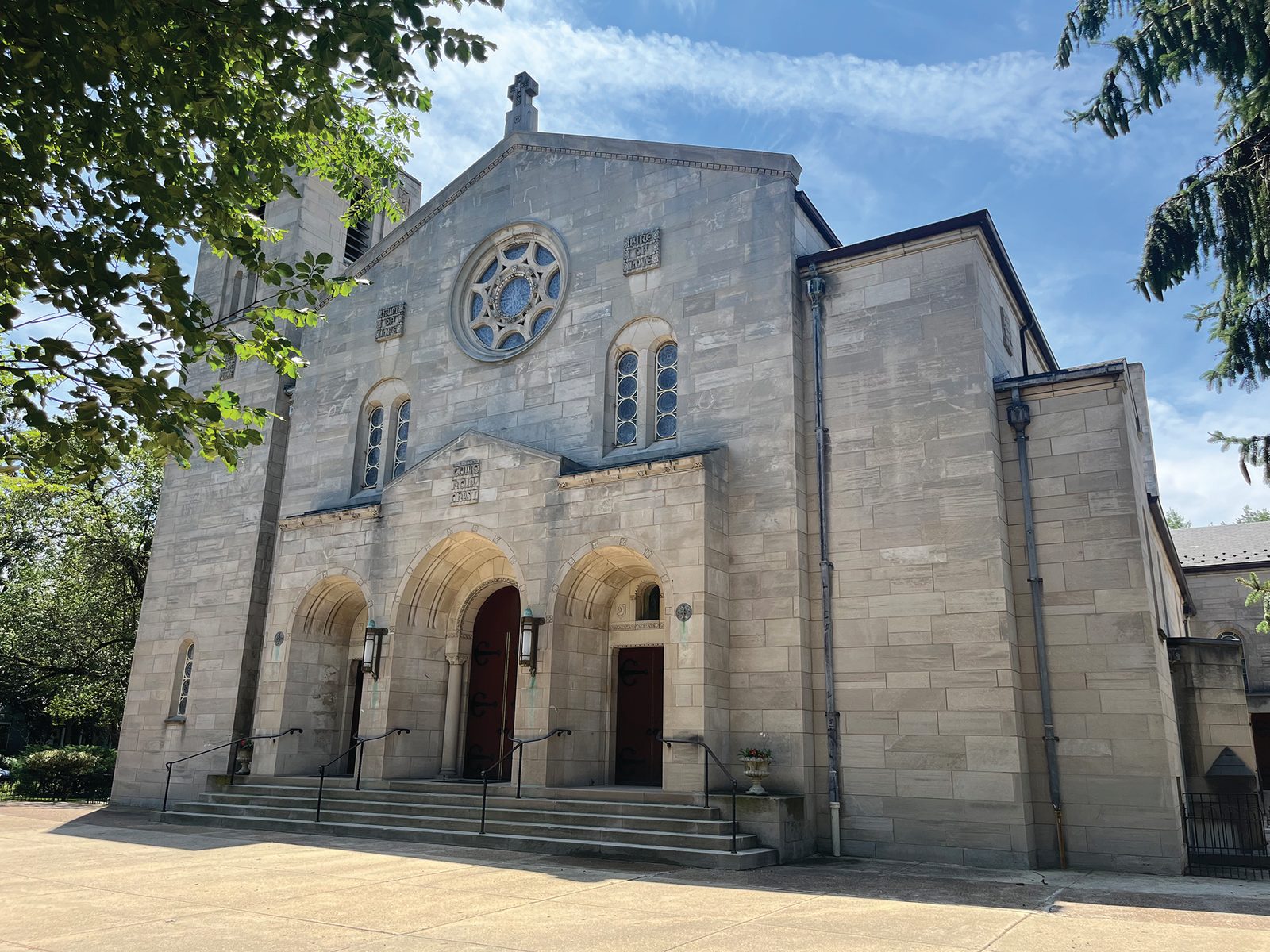
Holy Comforter-St. Cyprian Church, Washington
As a sacred pilgrimage site in Jubilee Year 2025, Holy Comforter-St. Cyprian Church in Washington, D.C., by its name, its history and its artwork reflects an enduring legacy of faith.
St. Cyprian Parish – named for a third-century African bishop and martyr who was an influential writer and teacher of the faith – was founded in 1893 to serve Black Catholics who had faced discrimination at St. Peter’s Church on Capitol Hill. Holy Comforter Parish, named after a title of the Holy Spirit, was established in 1904. The parishes were merged in 1966 and utilized the former Holy Comforter Church, which was built in 1939.
“It’s a place of enduring faith. This has remained a very strong parish for many years,” said Msgr. Charles Pope, the pastor of Holy Comforter-St. Cyprian Parish since 2007.
The diverse parish includes African American families, some with roots in the original St. Cyprian Parish, and a vibrant gospel choir sings at the 11 a.m. Sunday Mass. The parish also includes young adults who live and work in that area, and Capitol Hill staffers, members of Congress and employees of Washington think tanks and associations.
Msgr. Pope said he hopes that Jubilee Year pilgrims visiting Holy Comforter-St. Cyprian Church “experience it as a place of beauty and prayer.”
The design of the church’s sanctuary was inspired by the heavenly vision of St. John in the Book of Revelation, with its tabernacle, throne-like altar, seven tall candles and its clerestory windows depicting the four living creatures resembling a lion, an ox, a man and an eagle described in Revelation. On a wall of the sanctuary are painted the words: “Come O Holy Spirit, fill the hearts of thy faithful and kindle in them the fire of thy love.”
Along the upper walls of the church’s nave are dramatic murals depicting the lives of more than two dozen saints from around the world, each shown with the flame of the Holy Spirit above them, which Msgr. Pope said shows how by their holy lives, the Spirit of the Lord filled the Earth.
Transept windows depict symbols of the 12 apostles, and windows of the nave depict the seven gifts of the Holy Spirit and other related symbols and images. A remnant of the former St. Cyprian Church, a marble statue of that saint, is displayed in the back of the church.
Next to a large banner for “Pilgrims of Hope in Jubilee 2025, a display in the vestibule includes words of welcome to Jubilee Year pilgrims: “Holy Comforter-St. Cyprian Catholic Church has the honor of being a Jubilee 2025 pilgrimage site. Special blessings are available to all who attend or visit here seeking Jubilee graces. Come and experience grace and be renewed in the hope that does not fade, our hope in God!”
Fliers there offer information on the Jubilee Year and how to obtain an indulgence. Pilgrims can sign a Jubilee book and enter a prayer request. The parish bulletin notes that the “Pilgrims of Hope” theme for the Jubilee Year “emphasizes the journey of faith and the importance of hope in overcoming life’s challenges.”
Holy Comforter-St. Cyprian’s opening event for the Jubilee Year was its Lenten Family Day in March. The church’s traditions include outdoor Corpus Christi, Divine Mercy Sunday and May processions around the Lincoln Park neighborhood, and courtyard gatherings in front of the church to mark St. Cyprian’s Sept. 16 feast day, and a carnival this past spring to celebrate Pentecost.
“We try to stay out there (in the community),” Msgr. Pope said.
A banner on a fence outside the rectory promotes Eucharistic Adoration at the church every Friday from 6 to 7 p.m., and from 8 a.m. to 7 p.m. on First Fridays, and that Confessions are available every Friday from 6 to 7 p.m.
Masses are celebrated at 7 a.m. Mondays through Fridays, at 8 a.m. and at a 4:30 p.m. Vigil on Saturdays, and at 8 a.m., 9:30 a.m., 11 a.m. and 7 p.m. on Sundays.
Holy Comforter-St. Cyprian Church is located at 1357 East Capitol Street, S.E., Washington, D.C. The parish’s website is https://hcscchurch.org/. – By Mark Zimmermann
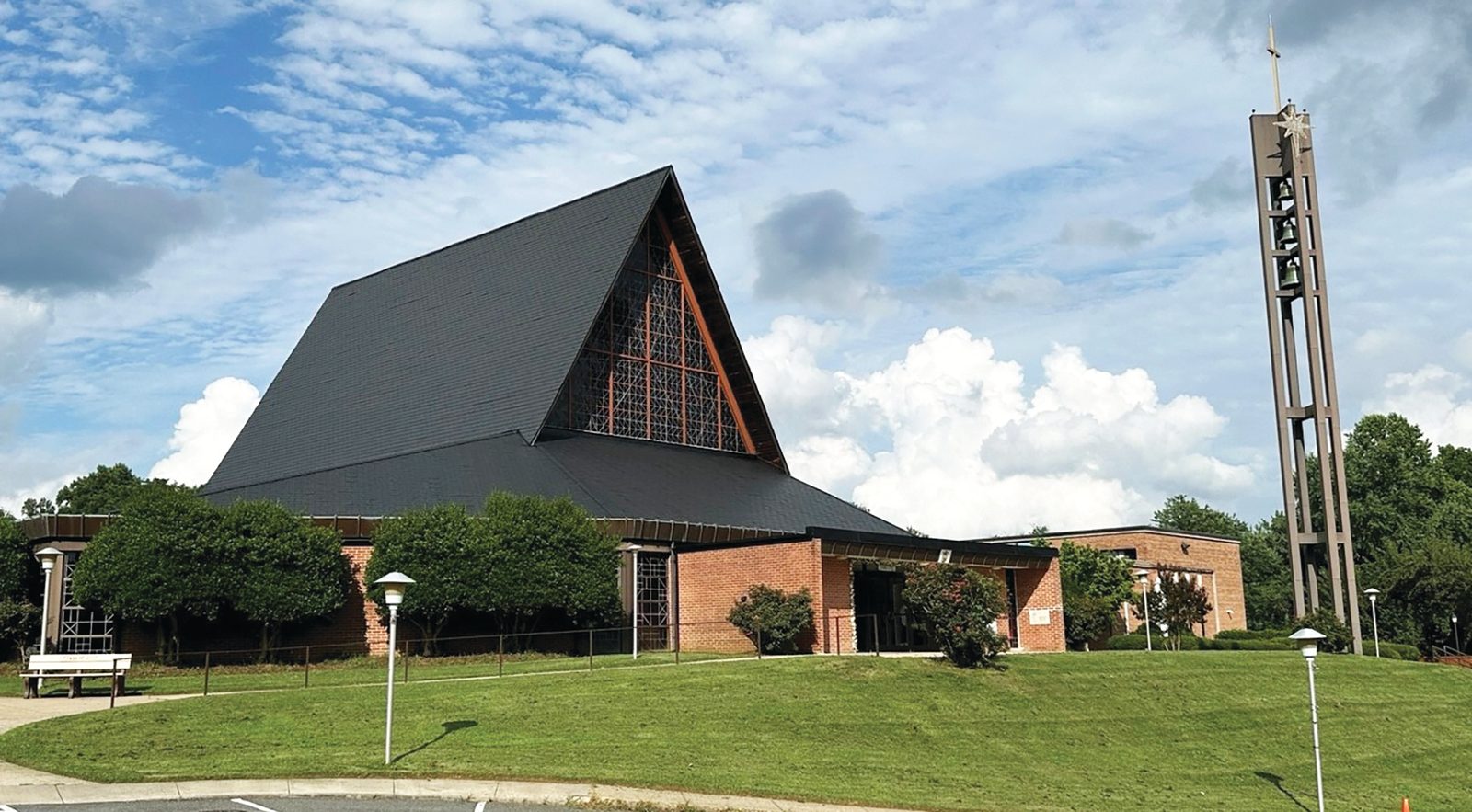
Shrine of St. Jude, Rockville
In a Jubilee Year in the Catholic Church that has the theme “Pilgrims of Hope,” perhaps it’s fitting that the Shrine of St. Jude in Rockville, Maryland has been designated as a Jubilee Church, a place of sacred pilgrimage within the Archdiocese of Washington. Since the parish was founded in 1956 and since its church at 12701 Veirs Mill Road was dedicated in 1971, St. Jude’s has been a special destination for people seeking Christ’s hope.
Named for St. Jude Thaddeus – one of Jesus’s 12 apostles who is the patron saint of hopeless causes – the parish’s church has a shrine to that saint, with a statue surrounded by flickering candles. Each represents a heartfelt prayer of someone facing a challenge in life, or offering a prayer for a friend or loved one facing difficulty. The Shrine of St. Jude includes statues of the Blessed Virgin Mary and St. Joseph, also surrounded on either side by rows of flickering candles.
The shrine is open during daylight hours, and people stop by to pray there throughout the day.
“People from all walks of life come here to pray,” said Father Paul Lee, St. Jude’s pastor since 2012. As a newly ordained priest in 1983, that was also the first parish where he served.
He noted that parishioners there are very devout, and St. Jude’s offers several different prayer groups and a Scripture study. The Shrine of St. Jude hosts a weekly novena with devotional prayers to St. Jude every Tuesday from 7 to 8 p.m., and an annual Solemn Novena to St. Jude starting nine days before his Oct. 28 feast day.
The parish bulletin notes that the shrine is known as “the beacon of Christ on the hill,” a landmark of faith overlooking Veirs Mill Road, where some parishioners continue to walk to the neighborhood church. St. Jude’s includes 2,800 families, about 40 percent of whom are Hispanic. St. Jude Regional Catholic School has about 220 students, and the faith formation program there serves about 600 youth.
The Shrine of St. Jude’s website is https://shrinestjude.org/
St. Jude’s offers weekday Masses at 6:30 a.m. and 9 a.m. in English, Saturday Masses at 7 a.m. and 8:30 a.m. in English, Saturday Vigil Masses at 5 p.m. in the shrine and 7:30 p.m. in the St. Clare Chapel, and Sunday Masses at 7 a.m., 8:30 a.m. and 10:30 a.m. in English and at 12:30 p.m. and 5 p.m. in Spanish. Confessions are offered there on Saturdays between 3:30 and 4:45 p.m. and by appointment. Every third Sunday at 3 p.m., Masses there are offered in the Tagalog language for Catholics with roots in the Philippines.
“We are one,” Father Lee said of the parish’s diversity, noting that parishioners are united in faith and take part in activities there together. That diversity has also been celebrated for the past 10 years in St. Jude Regional Catholic School’s annual International Day, which includes student performances highlighting different countries that they learned about in class, and parent volunteers serving cuisine from their native countries.
After the onset of the COVID-19 pandemic, St. Jude’s parishioners began offering another kind of hope to people in the community, launching the St. Stephen’s Food Pantry, staffed by parishioners of all ages, including college and high school students. The pantry continues to provide food to about 100 people every other Saturday.
“They (parishioners) took it as their mission. They’ve been doing it faithfully and with compassion,” Father Lee said.
Reflecting on the Shrine of St. Jude being a Jubilee Church, Father Juan Pablo Noboa, a native of Ecuador who has served there since his ordination two years ago, said, “We are a ‘yes’ parish.” He said in a world where people sometimes face doors shut to them, the shrine offers prayers, sacraments, food and Christ’s hope to people who come there.
“The heart of the parish has always been a jubilee parish,” he said. – – By Mark Zimmermann
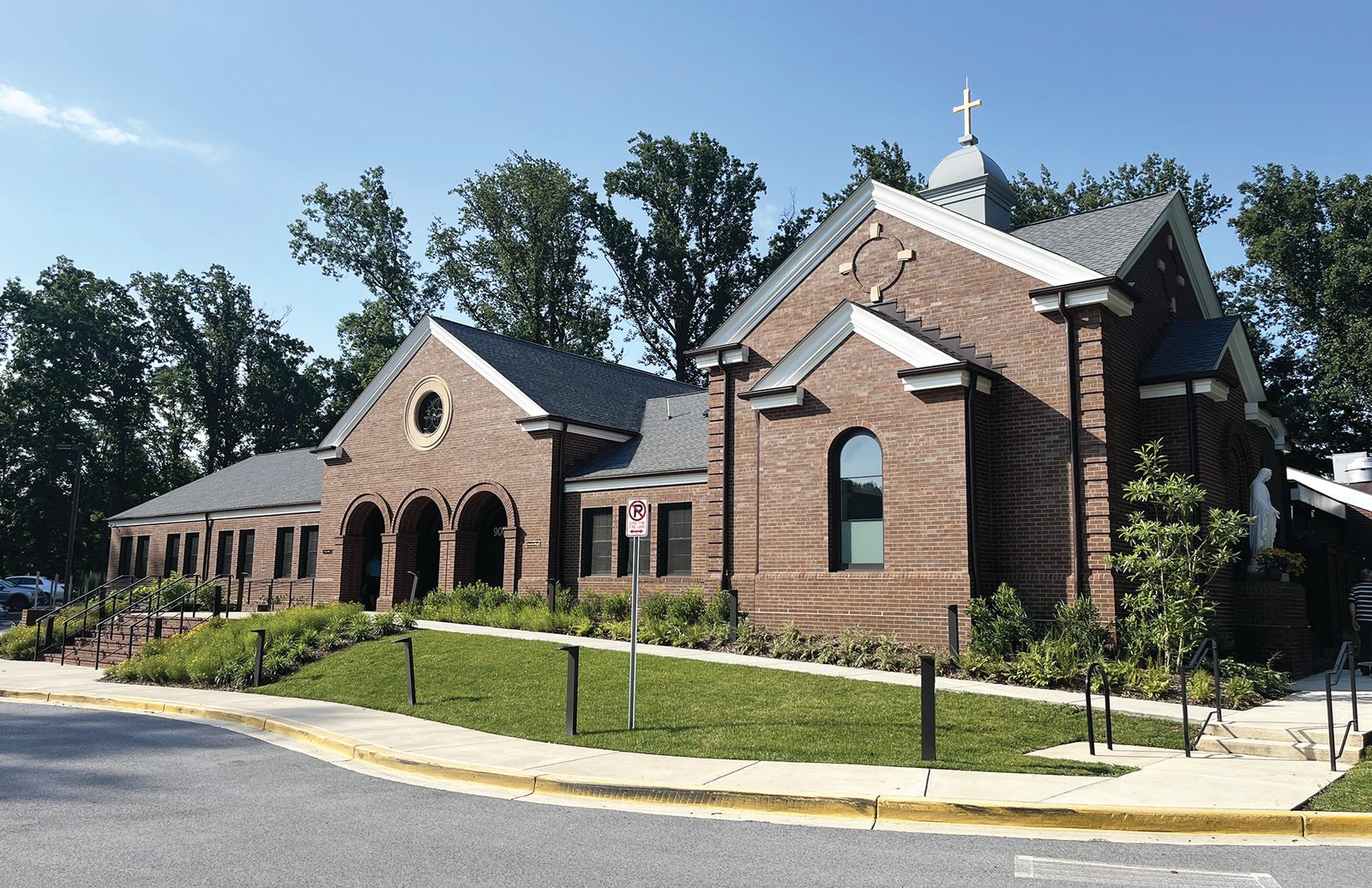
St. John Neumann Church, Gaithersburg
Eucharistic Adoration was central to the life of St. John Neumann, who promoted the 40 Hours Devotion in the United States. After immigrating to the United States, the native of Bohemia became a Catholic priest in the Redemptorist order and served from 1852-60 as the bishop of Philadelphia, where he founded the first Catholic diocesan school system in the United States.
That same devotion to the Eucharist is central to St. John Neumann Parish in Gaithersburg, Maryland, one of 12 designated Jubilee Churches in the Archdiocese of Washington for the 2025 Jubilee Year.
Visitors walking in St. John Neumann Church can see a doorway for the Chapel of the Sacred Heart, where Perpetual Adoration is open to the public between 5 a.m. and 10 p.m. daily.
“It’s a place where people can come any time, any hour to encounter Christ,” said Msgr. Robert Panke, the pastor of St. John Neumann Parish. “The beautiful thing I see in the Adoration chapel is families coming in, parents and children, at all times of the day.”
St. John Neumann Parish was founded in 1978, and after Pope St. John Paul II made his historic visit to Washington the next year, the large bas relief sculpture of “Christ among the Nations” that was used as the liturgical screen behind the altar for the pope’s Mass on the National Mall was given to the new parish, where it is now displayed to the right of the altar.
The first Mass was celebrated in the new St. John Neumann Church in 1984. Perpetual Eucharistic Adoration began being offered there in 2002, and during the initial weeks of the COVID-19 pandemic in 2020 when churches were closed as a safety precaution, the Eucharist was placed in a monstrance inside the church doors, and St. John Neumann parishioners knelt in prayer outside.
Msgr. Panke said the Chapel of the Sacred Heart has been described as “the heartbeat of the parish” and as “the fuel cell of everything we do.” In recent years, several St. John Neumann parishioners have been ordained to the priesthood and diaconate and entered consecrated life, and the priest said prayers in that chapel helped blossom those vocations.
That chapel, and its name, are “so fitting for the Jubilee Year,” said Msgr. Panke. He added, “It’s the loving heart of Jesus, the merciful heart of Jesus that reaches out to us in our need of renewal.” In the archway above the chapel’s tabernacle, the words of Jesus from the end of the Gospel of Matthew are displayed: “Behold, I am with you always.”
St. John Neumann Parish has a special web page at https://sjncatholic.org/jubilee that includes information on Mass times, the Confession schedule there, and information on its Sacred Heart Chapel. The web page also includes links explaining a Jubilee Year, local pilgrimage sites, indulgences, the Jubilee Prayer, and the Vatican Jubilee site. The page also offers information on scheduling a group pilgrimage there.
Daily Masses are celebrated at St. John Neumann on Mondays through Fridays at 6:30 and 9 a.m., and on Saturdays and holidays at 9 a.m. The Saturday Vigil Mass is at 5 p.m., and on Sundays, Masses are celebrated in English at 7:30, 9:30 and 11:30 a.m. and 5 p.m., and in Spanish at 1:30 p.m. The Confession schedule is Monday through Friday, 8:30 to 8:45 a.m. and on Saturdays, 9:45 to 10:30 a.m. and 3:30 to 4:45 p.m.
Visitors to the church can pick up a pamphlet explaining “How to receive a plenary indulgence in three easy steps,” and a holy card with the text of the Jubilee prayer. During the Jubilee Year, the parish has hosted bilingual events including Masses, prayers and talks.
St. John Neumann’s designation as a sacred pilgrimage site in the Jubilee Year has not been its only recent milestone. The food pantry established there serves the community every other Saturday. In 2023, the church’s new additions were blessed, including the expanded space for the Chapel of the Sacred Heart, a dramatic new exterior façade for the church, and a large welcoming space, where a new mosaic of the Holy Spirit was recently completed in time for Pentecost Sunday.
Msgr. Panke said St. John Neumann Church and its chapel have a special purpose, not only in the Jubilee Year, but every day. “Always coming to church is an encounter with the Lord and His love and mercy, and an opportunity to renew our relationship with Christ,” he said. – By Mark Zimmermann
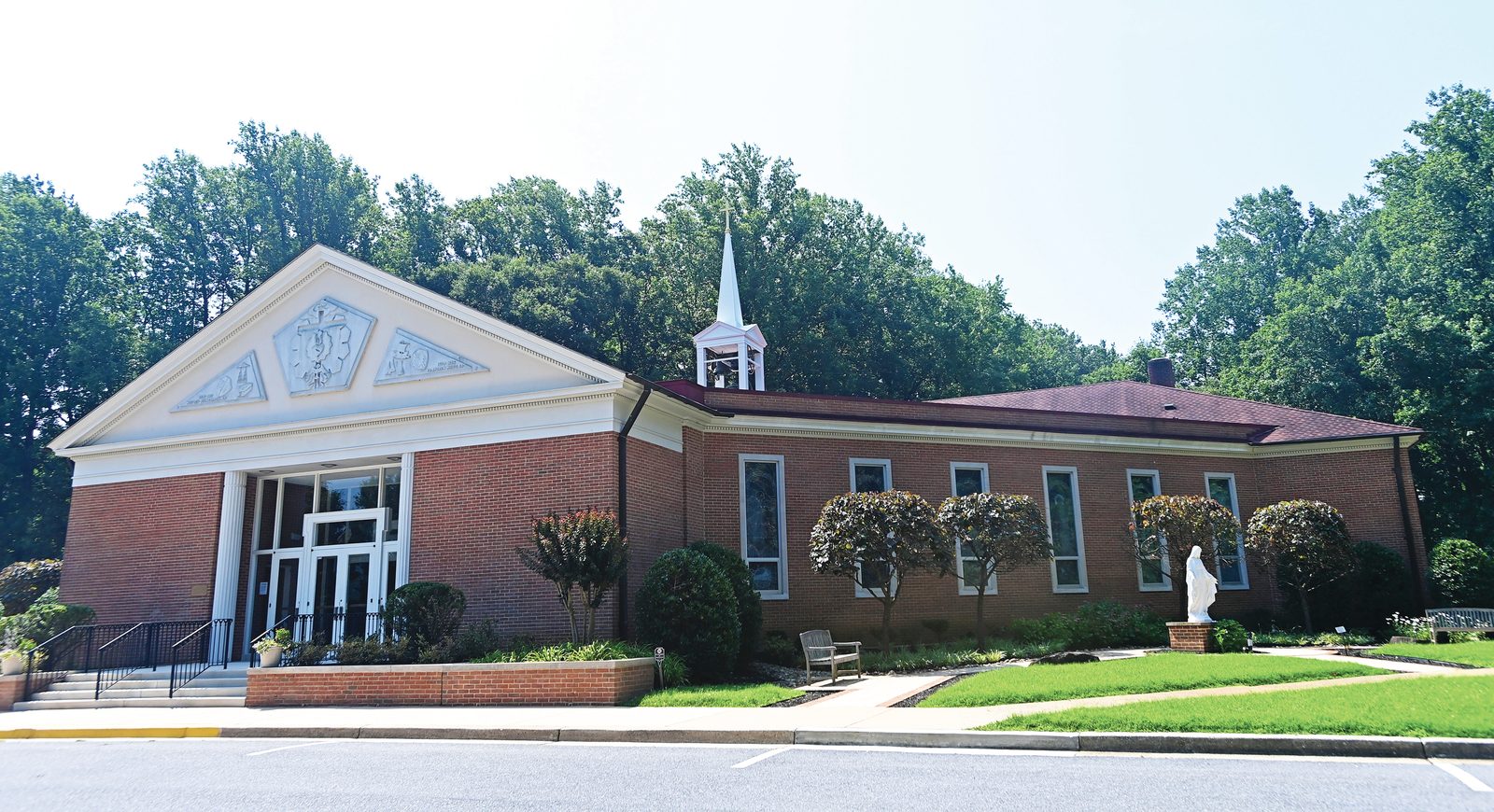
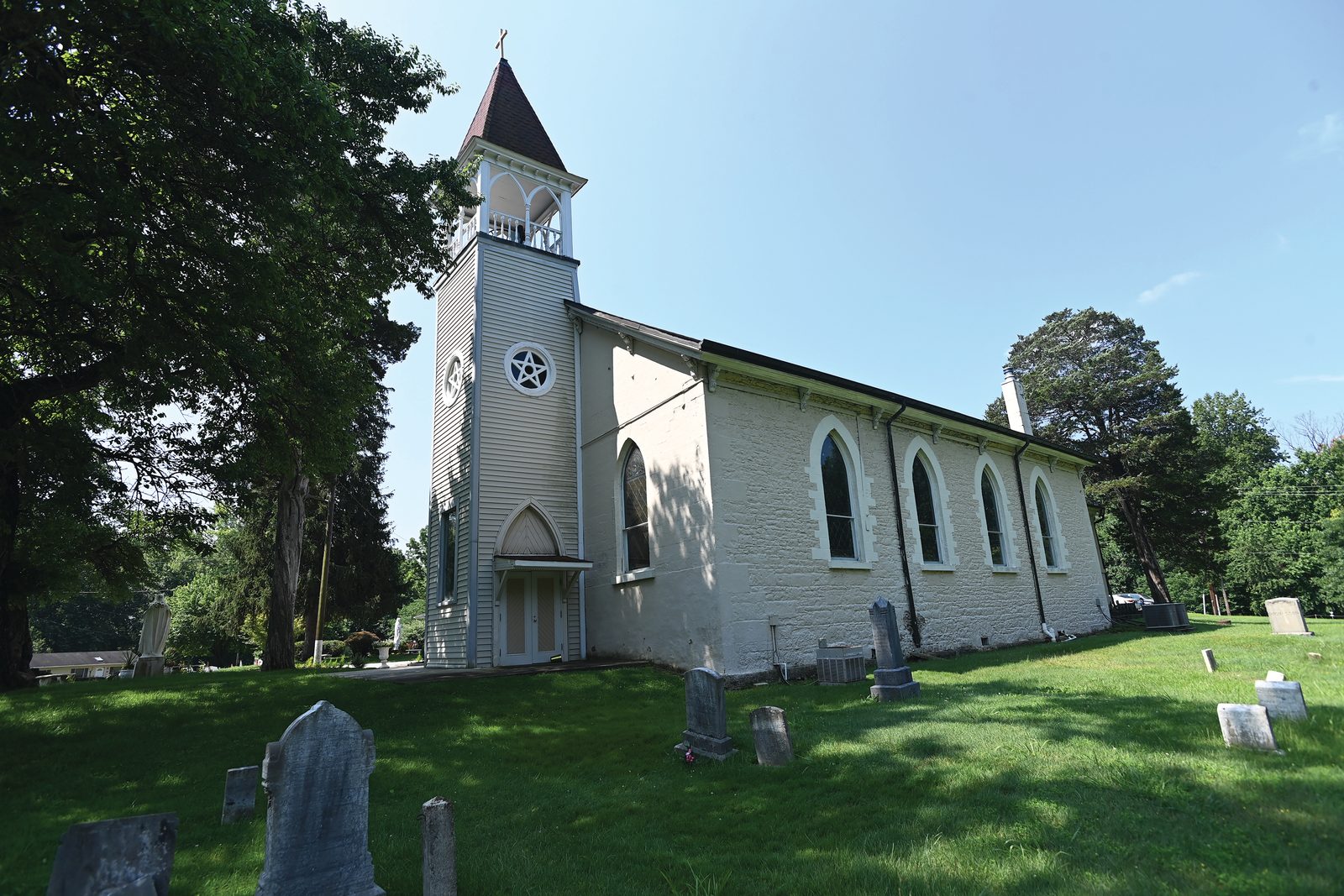
Sacred Heart Church, Bowie
Jubilee Year pilgrims to Sacred Heart Church in Bowie, Maryland – a designated sacred site for the Roman Catholic Archdiocese of Washington – will have more than just a church to visit.
“Our whole campus is a pilgrimage site,” said Father Michael Russo, pastor of the parish, explaining that the parish includes a more than 280-year-old chapel, a “new” church built in the 1960s, a grotto, a rosary walk and a parish cemetery.
The new church is the “Lord’s house,” Father Russo said, where about 850 families attend Mass. The crucifix in the new church is made from wood from the priest’s residence that was built in 1740.
“That residence burned in 1853 and the wood was salvaged,” Father Russo explained. “In the 1970s, that wood was used to make the beautiful crucifix that we have.”
The chapel, located a short walk up the hill from the new church, is “the spiritual heart of the place and the historical heart of the place,” Father Russo said.
In 1789 at the chapel, Father John Carroll was elected as the first bishop of Baltimore, becoming the nation’s first Catholic bishop, and Georgetown University was planned at that site.
Masses are offered in the chapel Monday through Friday at 8 a.m. – with an additional 6:30 a.m. Mass offered on Monday, Wednesday and Friday. Mass on Saturday in the chapel is offered at 9:30 a.m.
Confessions are heard there after the 6:30 a.m. Mass on Monday, Wednesday and Friday and after the 8 a.m. Mass on Tuesday and Thursday. Confessions are also heard on Tuesday from 5:30 p.m. to 6 p.m.
The chapel, Father Russo said, “is not a museum. It is a place to encounter the living God with everyone who has come before us.”
While noting “we have people visiting here all the time,” Father Russo suggested that pilgrims try to visit on a Tuesday. “That is the best day because we have all-day Adoration” of the Most Blessed Sacrament, he said.
The Sacred Heart Parish chapel is built on property that was one of the plantations owned by members of the Society of Jesus (the Jesuits) in Maryland in the 1700s and 1800s. In the last few years, unmarked graves were discovered throughout the 33-acre property with the use of ground-penetrating radar.
It is believed that the graves of more than 600 enslaved people who worked at that plantation may be located on the parish property. Some of those buried in the graveyard may be related to the 272 enslaved men, women and children the Maryland Society of Jesus sold in 1838 to Louisiana plantation owners which helped finance Georgetown College, which is now Georgetown University.
Sacred Heart Parish has been diligent in finding, blessing, and showing respect for the gravesites of those people who lie in the parish cemetery without name markers.
“We are trying to honor them. We are trying to offer hope – the theme of the Jubilee Year – and move forward,” Father Russo said. “Instead of just wallowing in how bad it was, we are doing something constructive that brings hope and brings people together.”
The effort to identify and dignify those graves is “a project that is sanctifying our community,” Father Russo explained, because “it is a work of mercy.”
At the back of the parish campus is an outdoor Stations of the Cross walk and a rosary walk that leads to the Our Lady of Rock Springs grotto. Built in the 1850s at a natural spring, the grotto was overgrown for many years, but was rediscovered and restored in the late 1950s.
Despite its location not too far from the busy intersection of Routes 450 and 301 in Bowie, the Sacred Heart Parish campus is an oasis of prayer and reflection.
“Just come up the road and into the woods and you are in a place of prayer and hopefully peace,” Father Russo said. “Come here and pray with the company of saints, surrounded by the graves of our brothers and sisters.”
Sacred Heart Parish is located at 16501 Annapolis Road in Bowie Maryland. For more information, visit https://sacredheartbowie.org. – By Richard Szczepanowski
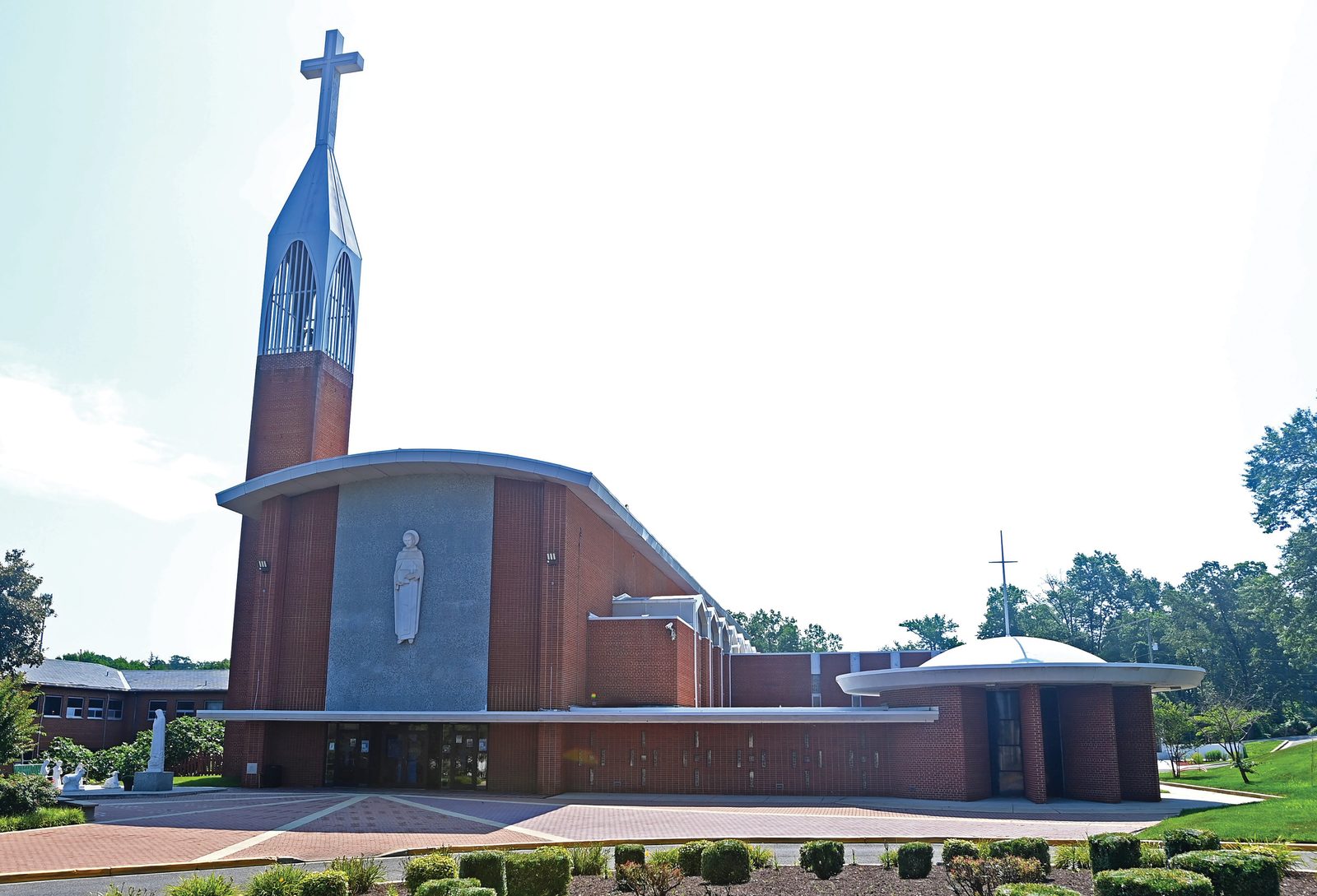
St. Bernard of Clairvaux Parish, Riverdale Park
Not too far from the Maryland Transit Administration’s Purple Line construction zone at the intersection of Kenilworth Avenue and Riverdale Road in Riverdale Park, Maryland is the parish church of St. Bernard of Clairvaux, one of the 12 “Jubilee Churches for sacred pilgrimages” within the Roman Catholic Archdiocese of Washington.
And, while the parish is located near the heavily trafficked and very busy construction zone, it offers Jubilee Year pilgrims a quiet and peaceful site to pray, meditate and contemplate.
“We encourage people to come and to learn about St. Bernard of Clairvaux,” said Scalabrinian Father Richard Gérard, pastor of the parish. “We want people to come here and make their devotions and know the spirituality of St. Bernard of Clairvaux.”
The parish recently marked the 75th anniversary of its founding. “We are celebrating our Jubilee Year during the Church’s Jubilee Year,” Father Gérard noted.
St. Bernard of Clairvaux Parish was created in the early 1940s as a mission of St. Jerome Parish in Hyattsville, and was established several years later as its own parish. The current church building was built in 1961. Today, the parish is administered by priests of the Congregation of the Missionaries of St. Charles Borromeo, popularly known as the Scalabrinians.
In the early 1990s, Spanish-speaking residents of Riverdale Park approached the parish seeking to have Spanish-language Masses offered there. At the time, Spanish-language Masses were offered at nearby St. James Parish in Mount Rainier and St. Mark the Evangelist Parish in Hyattsville, but the opening of the Metro Green Line changed public transportation routes and schedules, making it difficult for parishioners to attend those Masses.
In the last two decades, St. Bernard’s has experienced an increase in its young Hispanic population, and boasts a very large and active group of children and young people who attend the parish’s catechetical programs.
“We are a very young parish,” the priest noted, adding that “so many people in our parish come from Mexico, and we are sometimes called ‘the Mexican parish’.”
While the Spanish-speaking community in the parish has grown, other ethnic groups have also joined the parish. It now boasts a healthy community of Catholics from Vietnam, the Philippines and several African nations. More than 1,000 families call St. Bernard’s their spiritual home.
Father Gérard noted that it is fitting that the Scalabrinians staff the parish because “the founder of our order, St. John Baptist Scalabrini, worked with migrants just as we do today.”
The parish is actually home to two parishes – St. Bernard of Clairvaux Parish and Our Lady of Fatima, the parish for Portuguese-speaking Catholics. On the parish grounds are located two outdoor shrines: one to Our Lady of Fatima and another to Our Lady of Guadalupe.
A Jubilee Year pilgrim visiting the parish can participate in Adoration of the Most Blessed Sacrament every Thursday at 7:30 p.m. and receive the Sacrament of Confession every day from 6 p.m. to 7 p.m. Confessions are heard on Fridays from 5 p.m. to 7 p.m.
“If people who visit during the day want Confession, they can come (to the rectory) anytime, and we will hear them,” Father Gérard said.
St. Bernard of Clairvaux Parish is open every weekday from 8 a.m. when an English-language Mass is offered until after the Spanish-language Mass that is offered each evening at 7:30 p.m. The Saturday Vigil Mass is in Spanish, and on Sundays, six Masses are offered: one in English, one in Portuguese and four in Spanish. The parish has a table where the faithful can place their religious items for the priest to bless. Father Gérard said that the blessing of religious items is offered after every Mass celebrated there.
“People are welcome to come here and make their prayers and their devotions – no appointment needed,” Father Gérard said. “We are open to everybody, and we welcome them to a community that is beautiful and dynamic.”
St. Bernard of Clairvaux Parish is located at 5700 Saint Bernard Drive in Riverdale Park, Maryland, conveniently located just a couple of miles from both the Baltimore Washington Parkway and the Capital Beltway. – By Richard Szczepanowski
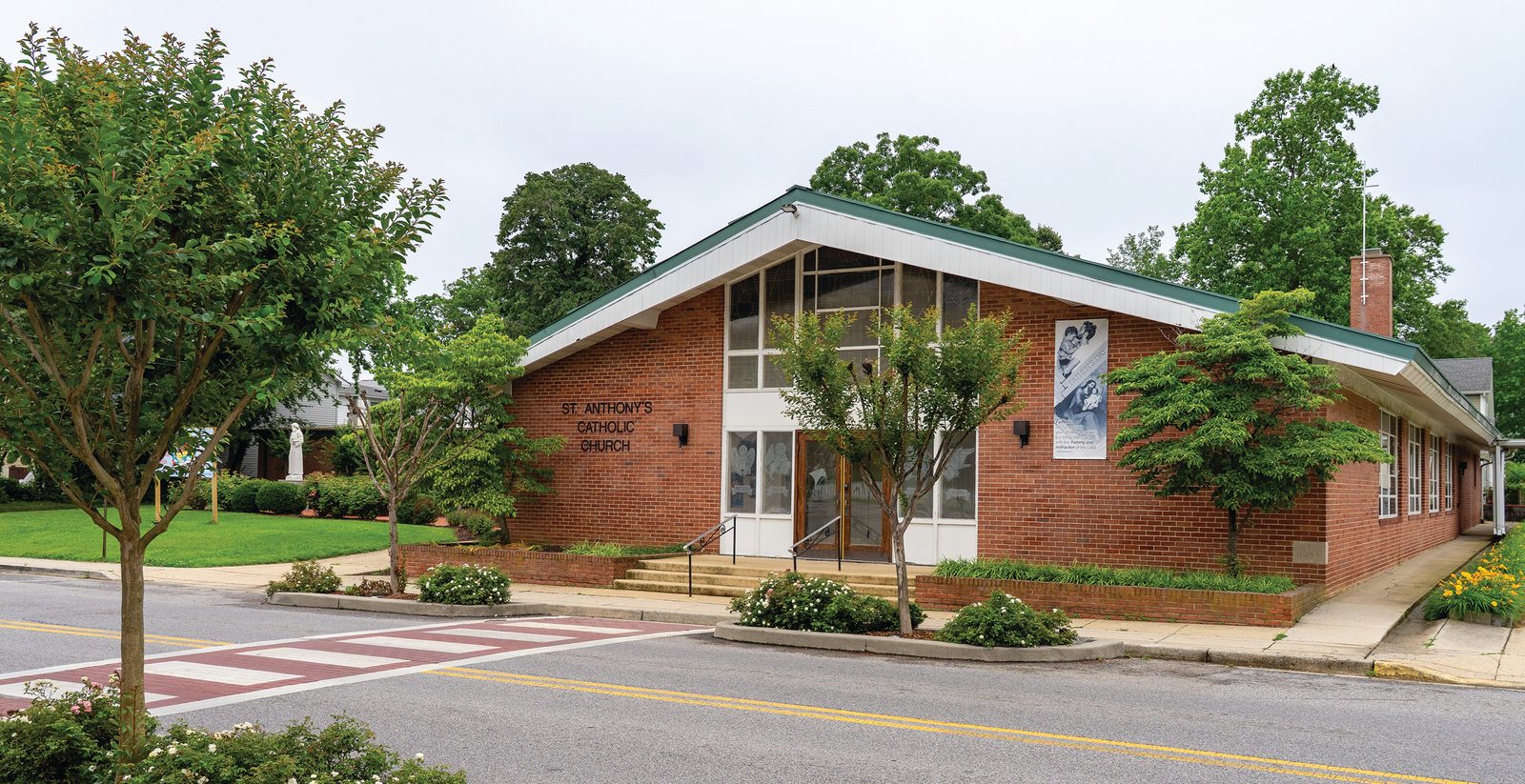
St. Anthony Church, North Beach
In North Beach, Maryland, pastel condos and beach cottages with rose gardens line the road along the Chesapeake Bay. The call of sea gulls and the hum of passersby drift from the boardwalk to the front garden of St. Anthony Catholic Church. Like the tide, the parish moves with a steady pull. Its life is shaped by the sacraments, hospitality and service during the Jubilee Year of Hope.
Parish secretary Terry DiGuiseppe has watched St. Anthony’s congregation grow and shift in recent years, as more young families put down roots in the quiet coastal town.
“We’re having more Baptisms than funerals these days,” she said.
While new families bring fresh energy, longtime ministries continue meeting the community’s spiritual and practical needs.
When St. Anthony Church was named a pilgrimage site for the Jubilee Year of Hope, DiGuiseppe called it “an unexpected honor,” but said it didn’t change how the parish operates.
St. Anthony Parish has continued its usual rhythm of liturgies, outreach and daily prayer. Father James Stack, the pastor there, has invited neighboring parishes to make pilgrimage visits, welcoming them to attend Mass and fulfill the Jubilee requirements for a plenary indulgence.
That quiet approach mirrors the parish’s beginnings. More than a century ago, when summer visitors arrived by rail from Washington, the Catholic community in North Beach gathered for Mass in a private home. Within a year, they built a modest chapel. St. Anthony’s was established as a mission in 1903 and became a parish in 1962.
Today that spirit of faith endures, as parish life at St. Anthony’s is rooted in prayer, marked by welcome and sustained by service.
In a message to parishioners earlier this year, Father Stack encouraged them to view the Jubilee not as a singular celebration, but as a way of living.
“The God who takes delight in His people wants us to celebrate the life that He has given us and to make merry ... as a way of rejoicing in the Lord,” he wrote.
At St. Anthony Church, life follows a familiar rhythm, steady as the tide. Daily Masses, weekend liturgies, Confessions, and Eucharistic Adoration anchor parish life, while monthly Healing Masses offer moments of restoration. The Adoration Chapel remains open throughout the week, inviting quiet prayer.
And sometimes, that prayer moves beyond the church. On Palm Sunday and Good Friday, parishioners carried their liturgy to the boardwalk, bringing their faith to the water’s edge.
The Jubilee Year isn’t about big shows or grand gestures, Father Stack said in his message to parishioners, adding that it’s about showing up for the people right in front of you.
“Loving the people whom God has placed us with is the best way of celebrating a Jubilee Year,” he said.
Masses are celebrated at St. Anthony Church on Saturdays at 9 a.m. and at the 4:30 p.m. Vigil Mass; on Sundays at 8:15 a.m., 11:15 a.m. and 3 p.m., with a Healing Mass on the first Sunday of the month; on Mondays through Fridays at 8 a.m.; a 7 p.m. Healing Mass on the third Tuesday of the month; and an 11 a.m. Mass on Fridays in the Adoration Chapel.
Confessions are available at the parish on Mondays from 6 p.m. to 7:45 p.m. during Eucharistic Adoration; on Saturdays from 3 p.m. to 4 p.m.; or by appointment by calling the parish office.
St. Anthony Church has Adoration of the Blessed Sacrament on Mondays from 6 p.m. to 7:45 p.m. and on Fridays from 8:30 to 9:30 a.m.
For more information on St. Anthony Parish in North Beach, go to the parish’s website at https://stanthonycal.us/ – By Nicole Olea
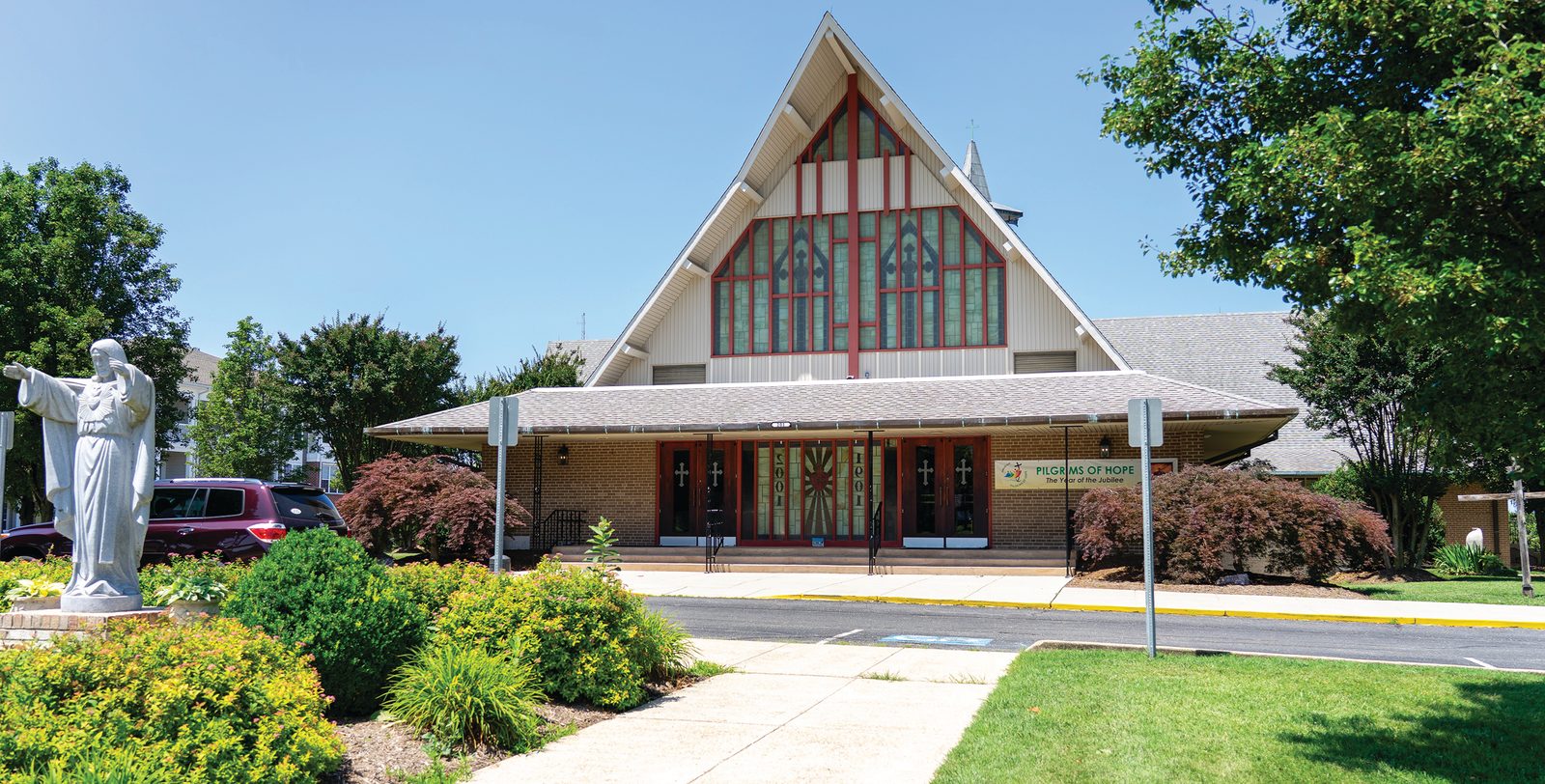
Sacred Heart Catholic Church, La Plata
Since it was designated as a Jubilee Year sacred site for the Roman Catholic Archdiocese of Washington, Sacred Heart Catholic Church in La Plata Maryland has seen an increase in the faithful who come to pray at the Charles County parish.
“More people have definitely have been coming,” said Father Scott Woods, pastor of the parish. “It’s amazing how parochial we can all be. People know their own parishes and the other parishes right by, but they rarely venture to parishes in other counties. In this Jubilee Year, more people are discovering that we are here.”
Jubilee Year pilgrims who visit Sacred Heart Church will have an abundance of opportunities to the receive the sacraments. Mass is offered every weekday at noon. In addition to the weekday Masses, a vigil Mass is celebrated on Saturdays at 5 p.m. and Sunday Masses are at 7 a.m., 9 a.m. and noon.
Confessions are also offered every weekday both before and after the daily Mass.
“We are very blessed to be able to do that,” Father Woods said of the ample opportunities offered there for Confession. “On the weekends we have Confessions before every Mass with so many people that we have to continue until the line ends. Particularly young people are coming to the sacrament, and that is really amazing.”
Father Woods noted that not only is the church “open all day long,” but the parish offers Monday-through-Friday Adoration of the Most Blessed Sacrament from after the noon Mass until 8:30 p.m.
“Having that (Adoration) every day is just really awesome and has made this a more vibrant place,” the priest said.
Next year will mark the 125th anniversary of the founding of Sacred Heart Parish. It was established in 1901, and the original church was built in 1903. In 1963, the present church was built. The parish was staffed by Jesuit priests until 1966 when archdiocesan priests took on the pastoral care of the parish. Between 800 and 1,000 families are members of the parish.
Being designated as a Jubilee Year pilgrimage site, “really means that we can bring more of the people of God to the many graces and indulgences of the Jubilee,” Father Woods said.
As part of the Jubilee Year, Father Woods said his parish has been offering “so many opportunities to grow in faith.” Among those opportunities are First Friday Masses with healing prayers and a First Saturday prayer breakfast with a guest speaker.
In September, the parish will begin offering a Pope St. John XXIII Family-Based Catechetical Program – an endeavor to teach the entire family their faith together. Parents or guardians and children meet two Sundays a month. Father Christopher Feist, the parish’s parochial vicar, and Bill Wannall, a pastoral associate, will conduct sessions for the adults. The children will be divided into age-appropriate groups and will be catechized by Sister Servants of the Lord and the Virgin of Matará and volunteer catechists.
“This is a jubilee parish, and there are many graces offered in the sacraments themselves and in the jubilee indulgences. I encourage people to take advantage of that,” Father Woods said.
Sacred Heart Catholic Church is located at 201 St. Marys Avenue in La Plata, Maryland. For more information, visit https://www.sacredheartlaplata.org/ – By Richard Szczepanowski
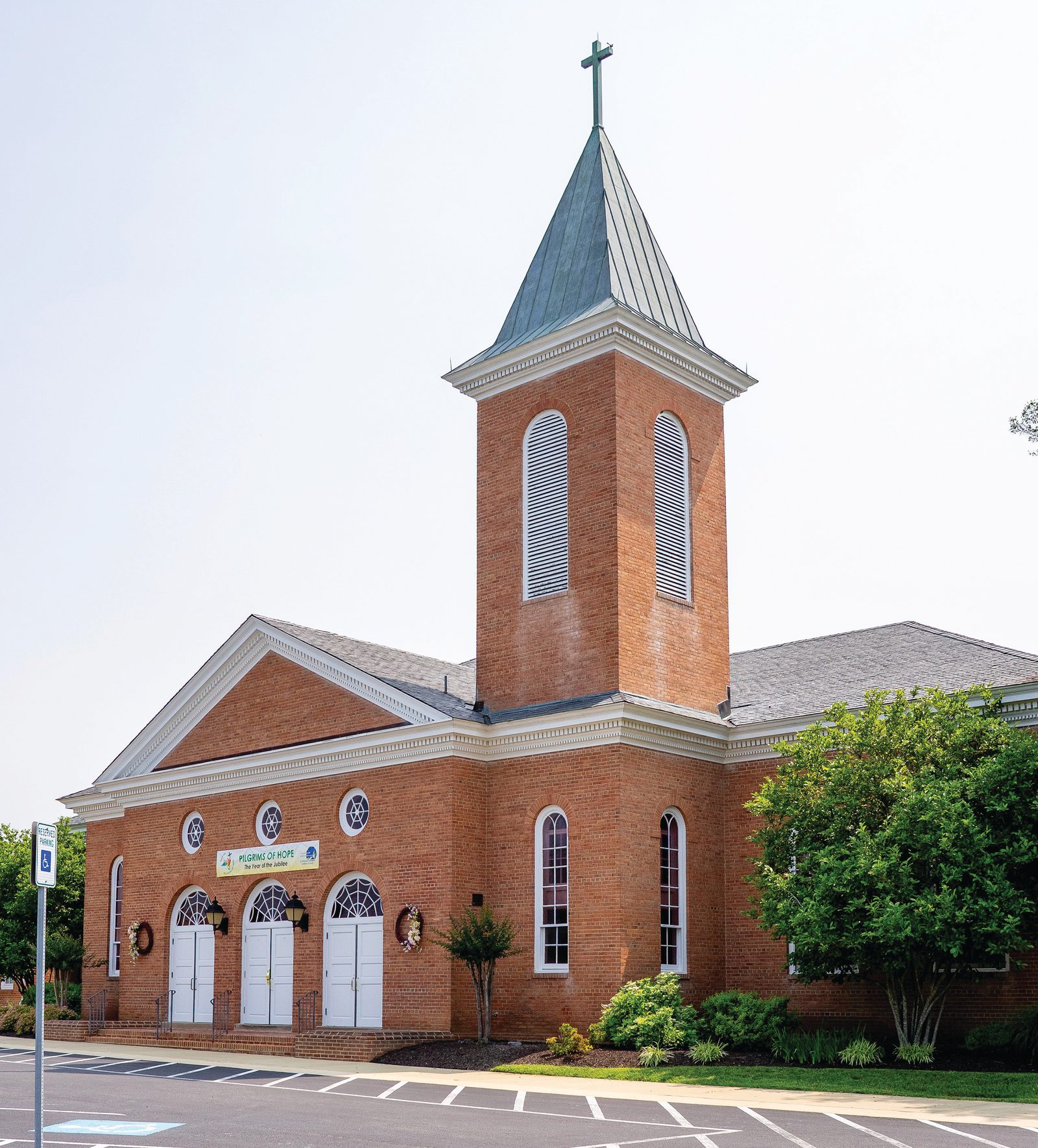
St. Aloysius Gonzaga Church, Leonardtown
St. Aloysius Gonzaga Church in Leonardtown, Maryland, is one of the designated Jubilee churches in the Roman Catholic Archdiocese of Washington, welcoming pilgrims to deepen their relationship with Christ during the Church’s Jubilee Year of Hope.
As a Jubilee church, St. Aloysius serves as a pilgrimage site where the faithful may receive a plenary indulgence under the usual conditions. Parishioners and pilgrims are encouraged to spend time in prayer, participate in the sacraments, and engage in acts of mercy during their visit.
Father David Beaubien, pastor of St. Aloysius, said the parish community hopes pilgrims experience the peace and presence of Christ.
“We want everyone who visits our church during this Jubilee year to feel welcome, to pray, and to reflect on the mercy of God,” Father Beaubien said.
To mark the Jubilee Year of Hope, the parish is hosting special Holy Hours and offering additional opportunities for the Sacrament of Reconciliation. Weekly Adoration of the Blessed Sacrament and daily Masses provide pilgrims with time for spiritual reflection and renewal.
Located at 22800 Washington Street near Leonardtown Square, the church is within walking distance of the waterfront and local shops, making it a convenient stop for those exploring Southern Maryland.
Father Beaubien said the parish’s blend of history and active ministry offers something meaningful for visitors.
“St. Aloysius has always been a place where faith is lived out through service, through education, and through our care for one another,” he said.
The parish traces its Catholic roots to Jesuit missionary activity in Southern Maryland in the 1600s and was founded in 1710. Today, it continues its legacy of evangelization through a variety of ministries and outreach efforts. These include a historical committee, support groups for mothers and combat veterans, special-needs initiatives, and a facilities team that helps care for the church grounds and buildings. The parish cosponsors Father Andrew White, S.J. School, which is located next to the church.
Asked what makes the parish special during this Jubilee year, Father Beaubien pointed to the faith-filled community and the parish’s ongoing mission.
“While we cherish our history, it’s the people who make this parish alive today – those who come to worship, to serve, and to share the love of Christ,” he said.
The church is open daily from 8 a.m. to 5 p.m. for pilgrims seeking quiet prayer or a visit to the Sacred Heart Chapel.
Masses are celebrated at St. Aloysius Church on Saturdays at 7:30 a.m. and at the 5 p.m. Vigil Mass; on Sundays at 8 a.m. and 11 a.m.; on Tuesdays and Thursdays at 12:15 p.m.; and on Wednesdays and Fridays at 8:30 a.m.
Confessions are offered on Thursdays from 11:30 a.m. to noon during summer; on Saturdays from 3:30 to 4:30 p.m.; on the second Sunday of the month after all Masses, and by appointment by calling the parish office.
Adoration of the Blessed Sacrament is held daily in the Sacred Heart Chapel from 6:30 to 7:30 a.m. and from 6:30 to 7:30 p.m.
For more information about Jubilee events at St. Aloysius Church, visit www.saintaloysiuschurch.org. – By Nicole Olea
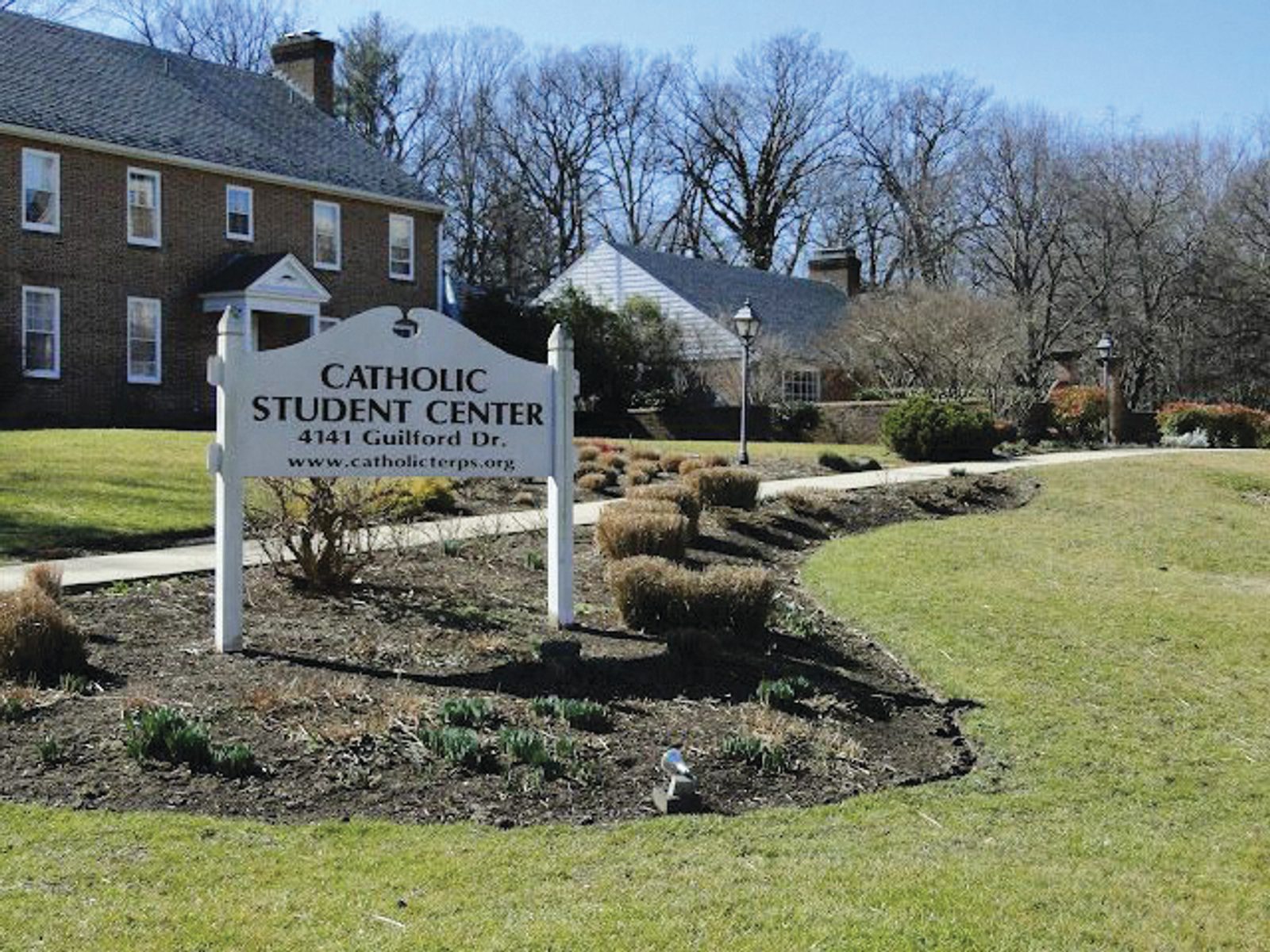
Catholic Student Center at the University of Maryland in College Park
Amid classes, exams and campus distractions, many University of Maryland students carve out time for prayer, worship and community. At the Catholic Student Center in College Park, faith is woven into daily campus life.
“It’s a blessing for our students to feel part of the broader Church, both here at the Catholic Student Center and within the archdiocese during this Jubilee year,” said Father Conrad Murphy, chaplain of the Catholic Student Center. “There is a greater connection to the Holy Father and a joy in sharing more broadly the good news and hope that is here.”
With the Catholic Student Center serving as a pilgrimage site for the Jubilee Year of Hope in the Roman Catholic Archdiocese of Washington, Father Murphy said, “We’re trying to center more of our activities around the Jubilee Year, and especially to emphasize the graces students can receive simply by coming to pray at the chapel.”
The message of mercy and reconciliation, he said, resonates with students facing academic and personal pressures.
“They deal with a lot of pressure and experience a real desire and need for mercy,” Father Murphy said. “We’re also encouraging them to use this opportunity to invite more of their friends and classmates into a deeper relationship with God, using the Jubilee graces as a spark.”
Despite the challenges, he described the Catholic Terps community as one marked by growth and joy.
“We have a really healthy and joyful culture among our students,” he said.
As the Catholic Student Center community has grown, with significantly increased Mass attendance this year and record participation in the Order of Christian Initiation for Adults in recent years, the center has launched a major construction project to meet the growing demand. The expansion includes a new Eucharistic Adoration chapel named for Blessed Carlo Acutis, who will be canonized on Sept. 7, 2025, becoming the first millennial saint. A first-class relic of Acutis, patron of the center, is already housed there.
During the academic year, the center’s spiritual life is anchored by a 5:30 p.m. Wednesday Mass, followed by a free dinner and fellowship. Opportunities for spiritual growth include Eucharistic Adoration, Bible studies, retreats and men’s and women’s ministry programs.
Students may also join the center’s service ministry by helping prepare meals every other week for individuals experiencing homelessness. Social events provide time for students to relax and build friendships beyond academics.
“Because we are mainly a campus ministry, most of our events are geared toward students,” Father Murphy said. “But as a Jubilee parish, the center is open to anyone who wants to come and pray during the school year.”
He said the center has also hosted Jubilee Nights of Hope for the wider community, offering Eucharistic Adoration, praise and worship, Confession and student testimonies.
When asked what he hopes pilgrims experience, Father Murphy said, “Hope for the future of the Church here in Maryland, both coming from their own experience with Christ in the chapel, but also by seeing our students.”
The Catholic Student Center is located at 4141 Guilford Drive in College Park. It is open daily from 9 a.m. to 9 p.m. during the fall and spring semesters. During breaks, it is open only for the 5 p.m. Saturday Vigil Mass and 10 a.m. Sunday Mass. Free parking is available after 4 p.m. on weekdays and all day on weekends. For more information about the Catholic Student Center, visit catholicterps.org. – By Nicole Olea
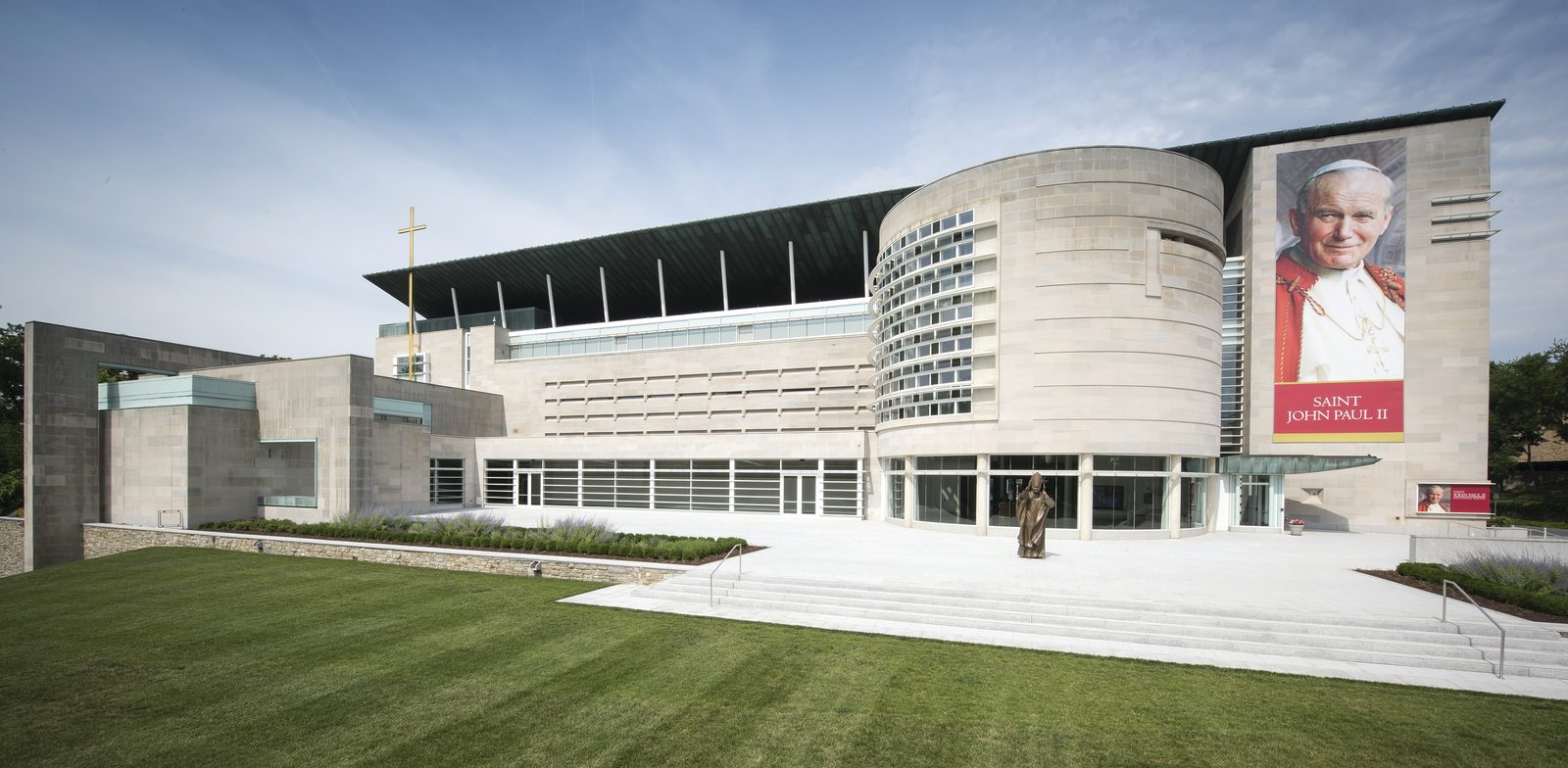
Saint John Paul II National Shrine
Just down the road from the Basilica of the National Shrine of the Immaculate Conception is another Jubilee Year sacred pilgrimage site: the Saint John Paul II National Shrine.
Begun in 2001 as the Pope John Paul II Cultural Center, the Knights of Columbus – in what it called a “major pastoral initiative” – in 2011 renovated the center and established the shrine to honor the legacy and mission of Pope (now Saint) John Paul II. The United States Conference of Catholic Bishops designated it a national shrine in 2014.
In May, the Roman Catholic Archdiocese of Washington’s local observance of the Jubilee Year, including a pilgrimage, took place at both the Saint John Paul II National Shrine and the Basilica of the National Shrine of the Immaculate Conception.
While it has been designated a pilgrimage site during this Jubilee Year, the Knights have always referred to shrine visitors as “pilgrims” who can pray, meditate and venerate a first-class relic of Saint John Paul II’s blood that is contained in a glass ampoule at the center of an ornate reliquary.
“By venerating the relics of Saint John Paul II, pilgrims seek his intercession, receive spiritual graces for their families and loved ones, and obtain the courage and spiritual strength to imitate his saintly life and persevere in their Christian witness to the Gospel,” the shrine’s website notes.
The Knights, in administering the Saint John Paul II National Shrine, point out that “through liturgy and prayer, art, cultural events, and religious celebrations, pilgrims can enter into our patron’s deep love for God and for man.”
In celebration of the Jubilee Year of Hope and the 25th anniversary of the Great Jubilee of the Year 2000, the Saint John Paul II National Shrine is hosting an exhibit on the jubilee tradition.
The exhibit, which continues through August, connects the advent of the Third Millennium and the Jubilee Year 2000 with this year’s Jubilee of Hope.
It features explanations on the tradition and theology of the jubilee, as well as objects and memorabilia from the shrine’s collection from the celebrations of the Jubilee of the Year 2000. Pilgrims will have the opportunity to proceed through the shrine’s main permanent exhibit, “A Gift of Love, The Life of Saint John Paul II.”
The exhibit also features a life-size replica of the Holy Doors and an explanation of the images found on them.
The shrine includes the Redemptor Hominis Church – where Mass is offered daily – and the Luminous Mysteries Chapel, which houses the reliquary with the vial of the saintly pope’s blood.
According to the Saint John Paul II National Shrine website, the relics in the Redemptor Hominis Church reflect the North American heritage of the Knights of Columbus and include those of Saint François de Laval, Saint Jóse María Robles Hurtado, Saint Kateri Tekakwitha, Saint Elizabeth Ann Seton, Saint John Neumann, and
Saint Junípero Serra.
The relics in the Luminous Mysteries Chapel recall the Polish heritage of Saint John Paul II and include those of Saint Maximilian Kolbe, Saint Albert Chmielowski, Saint Faustina Kowalska, and Saint Gianna Beretta Molla.
Masses are offered Monday through Saturday at noon and on Sundays at 11 a.m. in Spanish and at 2 p.m. in English. Confessions are available Monday through Saturday from 11 a.m. to 11:45 a.m. and on Sunday from noon to12:30 p.m. in Spanish and from 3:30 p.m. to 4 p.m. in English.
Every day, at 3 p.m. – the Hour of Mercy – the shrine hosts meditation and recitation of the Chaplet of Divine Mercy, a devotion particularly loved by Saint John Paul II.
The Knights encourage pilgrims to visit the Saint John Paul II National Shrine because “it is meant to be a place of genuine encounter with God that leads to a renewal of individuals, families, societies, and cultures – a place where God, who ‘entered history’ heals and renews every dimension of human life.”
The Saint John Paul II National Shrine is open weekdays from 10 a.m. to 3:30 p.m. and weekends from 10 a.m. to 5 p.m. The gift shop there sells religious articles.
It is located at 3900 Harewood Road, N.E. in Washington, D.C. More information can be found at www.jp2shrine.org. – By Richard Szczepanowski









